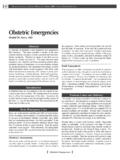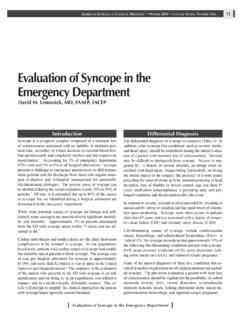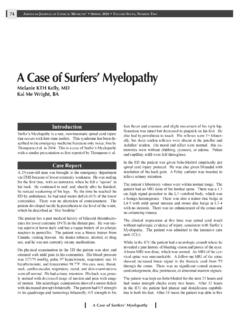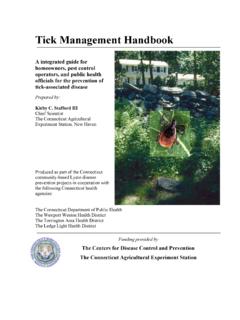Transcription of Lyme Disease and Rocky Mountain Spotted Fever
1 american JournAl of clinicAl medicine Winter 2009 Volume Six, number one19 Lyme Disease and Rocky Mountain Spotted FeverABSTRACTMost reported cases of Lyme Disease and RMSF occur in the spring and summer months when tick infestations reach their peak. The primary care physician can play an important role during peak periods by remaining vigilant to early signs of both Lyme Disease and RMSF. Although both Lyme Disease and RMSF are treatable, clinicians should be aware of early signs of both diseases to help reduce long-term complications. Patients should also be encour-aged to adopt personal protective measures to minimize exposure to ticks and, thus, either of these diseases. The following is a comprehensive overview in which pertinent diagnostic aspects of each Disease are highlighted with a particular emphasis placed upon the role of the primary care physician in treating and mini-mizing the risks of Lyme Disease and Words: Lyme Disease , Rocky Mountain Spotted Fever , Rickettsia rickettsii, american dog tick, Dermacentor variabilis, Ixodes tick, Borrelia burgdorferi, spirochete, tick-borne diseaseRocky Mountain Spotted Fever (RMSF) cases per 1 million persons in ,2 Over 90% of pa-tients with Rocky Mountain Spotted Fever are infected during summer months (Table 1).
2 1 Is most common in the Southeast-ern United overall mortality rate is currently 2; however, the case-fatality rate can be as high as in children under the age of Mountain Spotted Fever (RMSF), the most severe of the rickettsioses, is a serious tick-borne Disease that is endemic in the United It is caused by R. rickettsii and is transmitted by Dermacentor andersoni (wood tick) or Dermacentor variabi-lis (dog tick).4 Although it is most commonly known as a cause of Fever and rash, it can have systemic The ini-tial presentation of RMSF is often nonspecific and may resemble many other infectious and non-infectious diseases and can repre-sent a diagnostic The classic triad for the Disease is rash, Fever , and history of being bitten by a tick. Unfortunately, these findings are present in less than half of cases and only in the early clinical ,4 Most patients will complain of Fever (98%), rash (97%), nausea and/or vomiting (73%), and headache (61%), but can also present with no sign other than the rash (>50%).
3 5 Furthermore, although the dog tick is responsible for most cases of RMSF, less than half of those infected report antecedent tick rash seen in RMSF is characteristically macular, Spotted (petechial), and begins on the ankles and wrists and then general-izes throughout the This, perhaps, is due to the fact that the clinical picture changes according to how long prior to admis-sion the tick bite ,7,8 For example, in patients presenting within the first two weeks after the tick bite, typical symptoms would be very elevated Fever (often greater than 101), headaches, and constitutional symptoms such as myalgias, anorexia, diar-Lyme Disease and Rocky Mountain Spotted Fever :Diagnosis, Prevention, and ManagementRibhi Hazin, Jamil Y. Abuzetun, Manar Suker, of OnsetNumber of CasesTable 1: Monthly Case Distribution of RMSF in 20021 Lyme Disease and Rocky Mountain Spotted FeverAmericAn JournAl of clinicAl medicine Winter 2009 Volume Six, number one20rhea, or ,7 As a result of the nonspecific nature of such symptoms, patients living in endemic areas, who present with high Fever and a history of tick bite, should be considered for the Between 60-80% of patients presenting two weeks or longer after the tick bite will have the characteristic rash along with the aforementioned nonspecific ,8 DiagnosisLaboratory confirmation of the diagnosis can be attained via immunofluorescence assay (IFA)
4 , complement fixation, latex agglutination, or immunodetection to detect bacterial antigens in a skin biopsy ,8 Unfortunately, no rapid diagnostic test currently exists for RMSF and serologic confirmation of the disorder often requires serum obtained at least two weeks af-ter onset of Furthermore, culture of Rickettsia can only be done via specialized laboratories and often requires two weeks for confirmatory ,9 However, the rapid progres-sion of the Disease and the associated mortality make empiric therapy a standard of therapy even in the absence of serologic ,9 Delays in diagnosis and initiation of appropri-ate therapy are unacceptably common in RMSF, and, as a result, patient outcomes are often ,5 This is particularly troubling since up to 14% of infected individuals will develop neurologic lack of knowledge of RMSF among clinicians can be re-sponsible for the diagnostic shortcomings.
5 For instance, a recent study demonstrated that only 21% of family practice physicians and 25% of emergency medicine physicians surveyed were able to correctly identify the drug of choice for treating Continuing efforts to educate first responders and primary care physicians on the intricacies of the disorder should focus on appropriate selection of antibiotics and prompt initiation of em-piric prior to the onset of rash in suspected ,9 TreatmentThe current treatment of choice for RMSF is 200 mg of doxy-cycline until three days after resolution of ,10 Given the high mortality associated with the condition, it is recom-mended that doxycycline be prescribed empirically in all suspected The only exception is pregnant women for whom doxycycline should be Oral chloramphenicol therapy remains the only effective alternative in treating preg-nant women with ,8,11 All individuals suspected of the condition should receive prompt antimicrobial therapy to avoid potentially fatal ,11 Lyme DiseaseIncidenceThere are cases per 100,000 population with 93% of those cases occurring among residents in ten states, mostly in the northeastern United Disease is rarely Disease is a multisystem inflammatory condition caused by the organism Borellia burgdorferi, which is transmitted to humans by the bite of infected Ixodes The Disease exists in three distinct clinical stages, but clinical features and symp-toms of stages may Stage I describes early localize Lyme Disease .
6 Whose common features include flu-like symp-toms, chills, headaches along with erythema migrans (EM) or a circular red rash that tends to generalize from the site of the tick ,13 Although EM characteristically exists as a solitary lesion, in up to one-fourth of patients, multiple annular lesions may also develop. Stage II or early disseminated Lyme Disease describes the clinical features of the disorder several weeks to months after being Characteristic clinical features of Stage II include intermittent pain and swelling in the joints, especially the knees, weakness in the extremities as a result of neurologic deficits, and Stage III or late per-sistent Lyme Disease is often accompanied by chronic arthritis, numbness and weakness in the limbs, and In-creased risk of chronic neurologic and cardiac complications accompanies the onset of Stage III of the of salient clinical signs and accompanying history of exposure are important to accurately diagnose the condition.
7 The current diagnostic paradigm recommended is utilization of immunosorbet assay (ELISA) or immunoblotting, two tech-niques considered essential for ,19 Although it can be confirmatory, culturing B. burgdorferi from patient serum or skin specimens has proven largely ,21 Assess-ing serum for specific antibodies against B. burgdorferi can be an effective adjunctive diagnostic test, especially four to six weeks after onset of symptoms when such antibodies peak in ,21 TreatmentSince the preponderance of patients with early Lyme Disease can be cured with the appropriate therapy, the major goal of therapy in the Disease is to eliminate the causative Lyme Disease tends to be most responsive to therapy, particular-ly when treatment is initiated early in the course of the Disease . The treatment of choice for the disorder consists of oral doxy-cycline 100 mg for 21 days or oral amoxicillin 500 mg for 21 ,22 Treating patients in later stages of Lyme can pose a challenge.
8 However, treatment of Lyme-induced menin-gitis with intravenous penicillin G has demonstrated promising ,16 Further, Lyme-induced arthritis has been success-fully treated with oral antibiotics in the ,23 american JournAl of clinicAl medicine Winter 2009 Volume Six, number one21 Lyme Disease and Rocky Mountain Spotted FeverPreventionContrary to popular belief, both Lyme Disease and RMSF can occur throughout the country. As with any tick-borne Disease , all patients, especially those living in endemic areas, should be encouraged to adopt the following protective measures:24-281) Avoid sandals or open-toe shoes;2) Wear light-colored garments for easier identification of ticks;3) Spray tick repellant on exposed skin and over clothing;4) Wear long-sleeve shirts and long pants whenever possible;5) Tuck shirt into pants and pants into socks to prevent ticks from reaching exposed skin;6) Wear a hat;7) Check body for ticks at least once a day (especially in inguinal regions, on the scalp, and behind the neck);8) Avoid tick-infested areas, especially during peak months (spring/summer);9) Wash and dry clothing in high temperature in order to destroy lingering ticks.
9 10) Clear vines, leaves, or woodpiles around the home, as they can provide shelter for both RMSF and Lyme Disease tend to be most com-mon to specific geographic locales, both diseases can occur throughout the United States. Since the spring and summer months coincide with peak infestation of the ticks responsible for the two diseases, clinical awareness coupled with clinical preparedness can be instrumental in early recognition of these two diseases. Early diagnosis of both RMSF and Lyme Disease is critical, since untreated infection may cause irreversible dam-age to the central nervous and cardiovascular Hazin, , is a John F. Kennedy Fellow at Harvard University, where he is focusing on health policy and Y. Abuzetun, , is currently completing internal medicine residency training at Creighton University Medi-cal Center in Omaha, NE. He was recently appointed Chief Resident, a position he will assume in July Suker, , is a recent medical school graduate living in Omaha, NE.
10 She is currently raising a family prior to be-ginning her internal medicine residency, scheduled for Financial Conflicts of Interest: By AJCM policy, all authors are required to disclose any and all commercial, financial, and other relationships in any way related to the subject of this article that might create any potential conflict of interest. The authors have stated that no such relationships Centers for Disease Control and Prevention (CDC). Fatal cases of Rocky Mountain Spotted Fever in family clusters-three states, 2003. MMWR Morb Mortal Wkly Rep 2004;53 Chapman AS, Murphy SM, Demma LJ, Holman RC, Curns AT, McQuiston JH, et al. Rocky Mountain Spotted Fever in the United States, 1997-2002. Vector Borne Zoonotic Dis 2006;6 Doyle A, Bhalla KS, Jones JM 3rd, Ennis DM. Myocardial involvement in Rocky Mountain Spotted Fever : a case report and review. Am J Med Sci 2006;332 Simser JA, Macaluso KR, Mulenga A, Azad AF.












